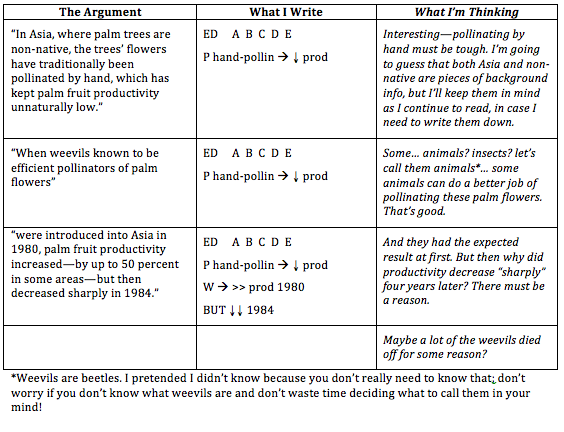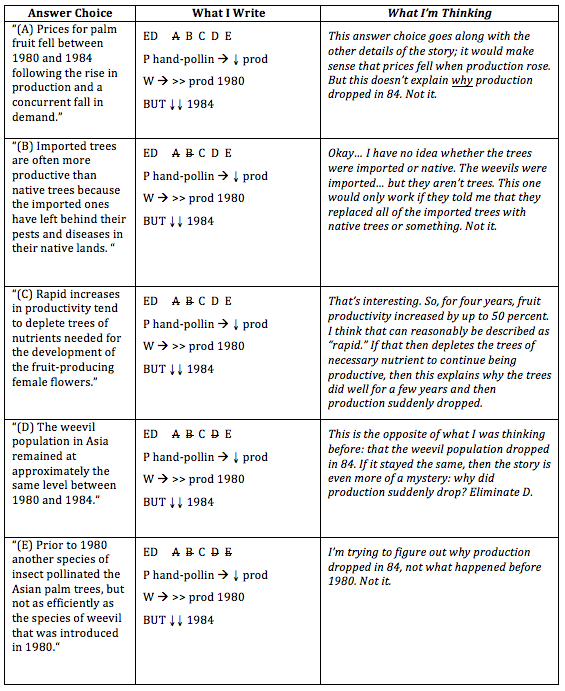-
Target Test Prep 20% Off Flash Sale is on! Code: FLASH20
Redeem
Explaining a CR Discrepancy
 Going for 90th+ percentile on verbal? Chances are youve spent most of your Critical Reasoning study time focused on the major question types, and that is a good place to start. If youre going for a very high verbal score, though, then youll also need to tackle the minor question types.
Going for 90th+ percentile on verbal? Chances are youve spent most of your Critical Reasoning study time focused on the major question types, and that is a good place to start. If youre going for a very high verbal score, though, then youll also need to tackle the minor question types.
Thats what were going to do today; below is a GMATPrep CR problem. Give yourself about 2 minutes to do this problem.
In Asia, where palm trees are non-native, the trees flowers have traditionally been pollinated by hand, which has kept palm fruit productivity unnaturally low. When weevils known to be efficient pollinators of palm flowers were introduced into Asia in 1980, palm fruit productivity increasedby up to 50 percent in some areasbut then decreased sharply in 1984.Which of the following statements, if true, would best explain the 1984 decrease in productivity?
(A) Prices for palm fruit fell between 1980 and 1984 following the rise in production and a concurrent fall in demand.(B) Imported trees are often more productive than native trees because the imported ones have left behind their pests and diseases in their native lands.
(C) Rapid increases in productivity tend to deplete trees of nutrients needed for the development of the fruit-producing female flowers.
(D) The weevil population in Asia remained at approximately the same level between 1980 and 1984.
(E) Prior to 1980 another species of insect pollinated the Asian palm trees, but not as efficiently as the species of weevil that was introduced in 1980.
(Note: if you arent yet familiar with the 4-step process for answering CR questions, take a look at this article.)
Step 1: Identify the Question
This question stem contains the classic clues for an Explain a Discrepancy question. These questions, like Strengthen and Weaken questions, typically include the words if true (or the equivalent). Further, the question literally asks what would explain something.
Step 2: Deconstruct the Argument
All right, this is a Discrepancy question. The argument wont contain a conclusion. Itll contain some facts, at least one of which is surprising in some way. It wont fit with the rest of the information.
Heres what I thought and wrote while I did the problem. Your own thought process wont be exactly the same as mine and, of course, your notes will probably look quite different, since we all have our own ways of abbreviating things. (Note: ED = Explain Discrepancy)

Step 3: State the Goal
This is a Discrepancy question, so I have to find the thing that doesnt fit in the argument and figure out what new piece of information would help the argument make sense.
In this case, the introduction of the weevils worked at first, but then production dropped again for no apparent reason. There must be some reason why, and Ive already brainstormed one: maybe something happened in 1984 to cause a bunch of the weevils to die, so they were no longer able to pollinate the trees at the same level.
Work from Wrong to Right

The correct answer is C.
Notice that wrong answer (D) did address the weevil populationjust not in a way that would help explain the story. Answer (A) is also tricky. It provided a detail that made sense with the story, but that detail didnt answer the specific question asked: why productivity decreased in 84.
Take-aways for CR Discrepancy questions:
(1) The question stem will usually contain the words if true along with a request to explain something.
(2) Once you realize you have a Discrepancy question, look for the surprising event or disconnect in the argument. The correct answer is going to hinge on this!
(3) Watch out for trap answers that do go along with the argument but dont specifically explain the discrepancy (like answer A in this problem). Also watch out for trap answers that seem to address the detail at issue, but instead just make the surprising event even more surprising (like answer D in this problem).
* GMATPrep questions courtesy of the Graduate Management Admissions Council. Usage of this question does not imply endorsement by GMAC.
Recent Articles
Archive
- May 2024
- April 2024
- March 2024
- February 2024
- January 2024
- December 2023
- November 2023
- October 2023
- September 2023
- July 2023
- June 2023
- May 2023
- April 2023
- March 2023
- February 2023
- January 2023
- December 2022
- November 2022
- October 2022
- September 2022
- August 2022
- July 2022
- June 2022
- May 2022
- April 2022
- March 2022
- February 2022
- January 2022
- December 2021
- November 2021
- October 2021
- September 2021
- August 2021
- July 2021
- June 2021
- May 2021
- April 2021
- March 2021
- February 2021
- January 2021
- December 2020
- November 2020
- October 2020
- September 2020
- August 2020
- July 2020
- June 2020
- May 2020
- April 2020
- March 2020
- February 2020
- January 2020
- December 2019
- November 2019
- October 2019
- September 2019
- August 2019
- July 2019
- June 2019
- May 2019
- April 2019
- March 2019
- February 2019
- January 2019
- December 2018
- November 2018
- October 2018
- September 2018
- August 2018
- July 2018
- June 2018
- May 2018
- April 2018
- March 2018
- February 2018
- January 2018
- December 2017
- November 2017
- October 2017
- September 2017
- August 2017
- July 2017
- June 2017
- May 2017
- April 2017
- March 2017
- February 2017
- January 2017
- December 2016
- November 2016
- October 2016
- September 2016
- August 2016
- July 2016
- June 2016
- May 2016
- April 2016
- March 2016
- February 2016
- January 2016
- December 2015
- November 2015
- October 2015
- September 2015
- August 2015
- July 2015
- June 2015
- May 2015
- April 2015
- March 2015
- February 2015
- January 2015
- December 2014
- November 2014
- October 2014
- September 2014
- August 2014
- July 2014
- June 2014
- May 2014
- April 2014
- March 2014
- February 2014
- January 2014
- December 2013
- November 2013
- October 2013
- September 2013
- August 2013
- July 2013
- June 2013
- May 2013
- April 2013
- March 2013
- February 2013
- January 2013
- December 2012
- November 2012
- October 2012
- September 2012
- August 2012
- July 2012
- June 2012
- May 2012
- April 2012
- March 2012
- February 2012
- January 2012
- December 2011
- November 2011
- October 2011
- September 2011
- August 2011
- July 2011
- June 2011
- May 2011
- April 2011
- March 2011
- February 2011
- January 2011
- December 2010
- November 2010
- October 2010
- September 2010
- August 2010
- July 2010
- June 2010
- May 2010
- April 2010
- March 2010
- February 2010
- January 2010
- December 2009
- November 2009
- October 2009
- September 2009
- August 2009